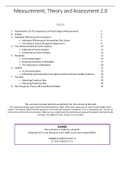Samenvatting
Summary measurement theory & assessment (MTA) 2, VU
- Instelling
- Vrije Universiteit Amsterdam (VU)
- Boek
- Psychometrics
Summary of the lectures of Measurement theory & assessment 2. Also summarised most of the chapters from Psychometrics: An introduction 3rd edition R. Micheal Furr (chapters required by the course).
[Meer zien]





